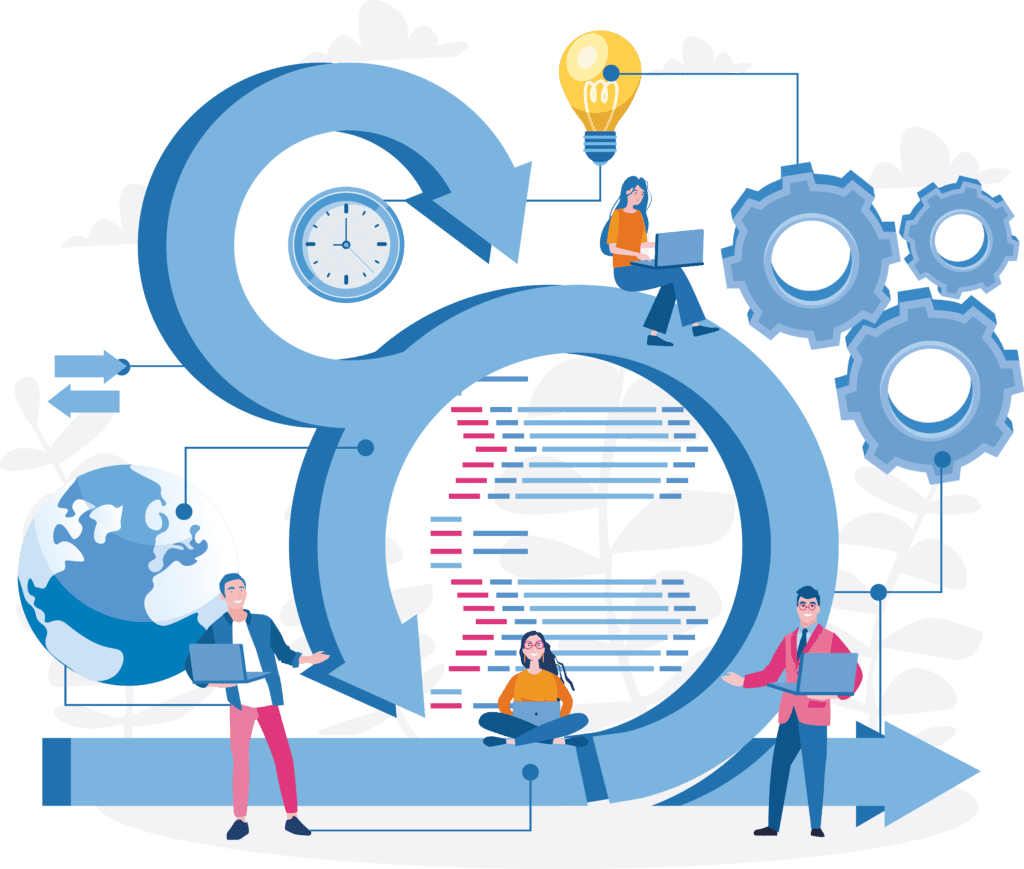
Scrum, the most widely used agile development method, is mainly used in software development. It also offers far-reaching application opportunities and advantages in many other areas.
In this article, we will show you the specific advantages Scrum offers in project management. If you are not yet familiar with the subject and would like basic information on the topic of agility, we recommend our article Agility – trend or company optimization? on our website.
Agile project management in a nutshell: specific advantages of Scrum
Scrum is based on a framework of roles, events, and artifacts. These provide transparency, structure, and a clearly defined work process to a team, based on agile principles.

Regular and sustainable certainty of results
Scrum leads to a strong and regular certainty of results through short-cycle iterations – also called “sprints”. The aim is to achieve an (intermediate) result, called a product increment, that is built into the work process at the end of each iteration. Continuously checking the (interim) results, in turn, enables more flexible and precise planning – and also sustainably increases the certainty of results.
Reliable project timelines and independent work
Good planning forms the foundation for project success. Scrum perfects this principle: each sprint becomes a project within a project. It reduces the “time-consuming” task of long-term planning to a minimum. This enables a more accurate estimation of the project duration due to the intermediate result density from the sprints as well as the estimation of tasks still open in the task pool, called the product backlog. The result: reliable project timelines can be achieved. In addition, this focus promotes independent work in the team and thus increases motivation.
Maximum transparency and regular communication
Customers and stakeholders are informed about the (interim) results at regular intervals and asked for their feedback. This offers maximum transparency. And makes it possible to correct the course of the project. Regular iterative engagement from decision-makers allows decisions to be made faster and further down the hierarchy. Both sides, the project team as well as the customers/decision-makers, gain more freedom.
How does Scrum achieve that? Our consultants will be happy to give you an answer. Or attend one of our Webinars on agile methods and topics – save your spot now and get to the root of process optimization!
Scrum explained in a nutshell: the framework of roles, events and artifacts
Scrum is a very simply structured framework and essentially consists of 11 elements, which are summarized in events, roles, and artifacts.

Events
The events are called Sprint, Sprint Planning, Daily Stand-up, Sprint Review, and Sprint Retrospective and are used to structure the short-cycle iterations. The sprint is the overarching iteration, which could also be understood as a clock of sorts, and is set for a period of 1 to 4 weeks. The other events are the meetings in the sprint process, which neatly structure the work process.

Roles
The Scrum role model distinguishes between a role that says WHAT is to be done (Product Owner) and a role that says HOW something is to be done (Developer/Development Team). In addition, there is the role of the Scrum Master, who is responsible in particular for the sustainable implementation of the iterative approach and leadership behavior.

Artifacts
The artifacts reflect the roles (Product Backlog for the Product Owner, Sprint Backlog for the developers) and provide orientation to the Sprint in the generation and review of results via the Product Increment.
Obstacles when introducing Scrum

Scrum was originally created for software development. But it can be used far beyond the software sector – as Scrum offers you an agile project management tool. However, some obstacles may arise during the implementation. These challenges are not necessarily to Scrum’s detriment – provided you keep the following in mind:
Shippable products after each sprint
A (potentially) Shippable Product Increment after each Sprint is seen as a vision and therefore not required. However, based on the maturity growth, the fastest possible clocked release time for generating the next product maturity level is determined together with the team and worked through with the sprint philosophy. The product development process and project plan serve as an orientation point for planning the process flow with a 10-week outlook.
Dealing with an established role model and leaders
The classic role model of project management does not work with Scrum: project leaders are used to taking the lead of the team – but with Scrum, Scrum Masters take on the position as facilitators who accompany the team.
Therefore, it often makes more sense to fill the role with someone who does not have a separate goal in the project. Instead, they focus on ensuring the team’s smooth process flow.
Leaders are not mentioned in Scrum. Since Scrum is a framework for action, the principle of individual adaptation and review in the sprint retrospectives applies here. Particularly in a project mesh of large projects, smaller projects, and process-related work, a company-specific approach must be found that includes the leaders.
Smaller projects and procedural work
A portfolio with many small projects and procedural work is an indication of less complex issues that can be handled much more efficiently than with Scrum by applying familiar management methods such as the product development process or specific work instructions (e.g., in test departments) in departments specialized for this purpose under the direction of leaders.
It is therefore first necessary to determine the project’s degree of complexity and select the most appropriate management method for it. A very well-known method in this context is Kanban boards in indirect areas to optimize the flow of tasks.
Customization of the Scrum framework via product creation archetypes
Now it is necessary to determine the appropriate mix of method support for a company along with the complexity levels of the projects and tasks. The following four archetypes of product creation are suitable for this purpose:
Process:
a sequence of tasks to a concrete result. In the context of product development & maintenance, this term is often used for small, well-known task packages that do not require a project to complete.
Customization development:
minor product enhancements that are not expected to pose major difficulties either regarding the requirements or in terms of new technologies to be used.
New product developments:
deliberately initiated projects to significantly renew an existing product.
Innovations:
They arise when a market need meets an enabler technology and is, at least for the company, completely new territory. Processes must be “rediscovered”. This implies an increased probability that chosen paths may fail.
Adapting the Scrum framework correctly increases transparency, speed, and consistency of results of each of these four archetypes:
Based on the existing task and project portfolio as well as the corporate structure, the events, roles, and artifacts are meaningfully coupled with established frameworks such as the product development process.
For example, in the process archetype, events coincide with planning, review, and retrospective elements in a regular stand-up.
In the area of customization development, the question of how to properly integrate the interdisciplinarity of project teams with many parallel projects is the main focus. The Scrum role “developer” must be seen much more broadly here since many tasks are in the supply chain. Multi-project boards help when working on several projects at the same time in the same team.
New product developments benefit from the strict use of the Scrum approach, especially for development tasks. However, the approach often needs to be scaled due to the task size and the associated number of developers. In addition, the interdisciplinary project members from logistics, purchasing, quality, and production must be properly integrated and the design transfer must be properly prepared. A transition to a more process-driven approach following an established product development process is often important, especially in later development phases.
Generating results quickly helps explore new territory. Scrum in its pure form is therefore the tool of choice when exploring innovations.
Free webinar:
One Scrum for all cases? One Scrum for every case!
Do you want to deepen your theoretical knowledge regarding Scrum with more content? Then register directly for our free webinar






